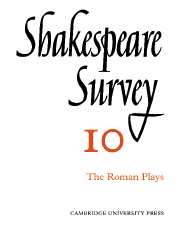Book contents
- Frontmatter
- Shakespeare’s Roman Plays: 1900–1956
- Shakespeare’s ‘Small Latin’—How Much?
- Shakespeare and the Elizabethan Romans
- The Metamorphosis of Violence in Titus Andronicus
- From Plutarch to Shakespeare: A Study of Coriolanus
- The Composition of Titus Andronicus
- Classical Costume in Shakespearian Productions
- Shakespeare’s Use of a Gallery over the Stage
- Lear’s Questions
- “Egregiously an Ass”: The Dark Side of the Moor. A view of Othello’s Mind
- Shakespeare in Schools
- Shakespeare Festival, Toronto, Canada
- International Notes
- Shakespeare Productions in the United Kingdom: 1955
- Drams of Eale, A Review of Recent Productions
- The Year's Contributions to Shakespearian Study 1 Critical Studies
- 2 Shakespeare’s Life, Times and Stage
- 3 Textual Studies
- Books Received
- Index
- Plate Section
Classical Costume in Shakespearian Productions
Published online by Cambridge University Press: 28 March 2007
- Frontmatter
- Shakespeare’s Roman Plays: 1900–1956
- Shakespeare’s ‘Small Latin’—How Much?
- Shakespeare and the Elizabethan Romans
- The Metamorphosis of Violence in Titus Andronicus
- From Plutarch to Shakespeare: A Study of Coriolanus
- The Composition of Titus Andronicus
- Classical Costume in Shakespearian Productions
- Shakespeare’s Use of a Gallery over the Stage
- Lear’s Questions
- “Egregiously an Ass”: The Dark Side of the Moor. A view of Othello’s Mind
- Shakespeare in Schools
- Shakespeare Festival, Toronto, Canada
- International Notes
- Shakespeare Productions in the United Kingdom: 1955
- Drams of Eale, A Review of Recent Productions
- The Year's Contributions to Shakespearian Study 1 Critical Studies
- 2 Shakespeare’s Life, Times and Stage
- 3 Textual Studies
- Books Received
- Index
- Plate Section
Summary
We are fortunate in having precise knowledge of early seventeenth-century conceptions of classical costume for the stage, in the attempts made at recollecting ancient examples, and the equally important theatrical variations in masque costume à la romaine. The interplay of these two factors—the recurring attempts to return to original sources and the enduring conservatism of the masque tradition—constitutes the chief visual interest of the Roman plays in the theatre. Even when conscientious archaeological research was at its greatest, in the age of Kemble and again in E. W. Godwin’s contribution to the late nineteenth-century stage, remembrances of Inigo Jones still remained.
Renaissance art had established its attitude to the antique in the generations before Shakespeare. Mantegna, more than a century earlier, had looked with profit at classical monuments and triumphal arches. The aim, fidelity to ancient models, is best summarized in Cesare Vecellio's Habiti Antichi et Moderni di Tutto il Mondo, first published in 1598, with engravings by Titian. This comprehensive work opens with Roman costume, and like all succeeding scholars, VeceUio goes to sculpture and bas-relief for his main material, beginning with "quelle quattro figure di porfido di relievo pieno, armate, le quali sono dinanzi alia porta del palazzo di S. Marco".
- Type
- Chapter
- Information
- Shakespeare Survey , pp. 71 - 76Publisher: Cambridge University PressPrint publication year: 1957

